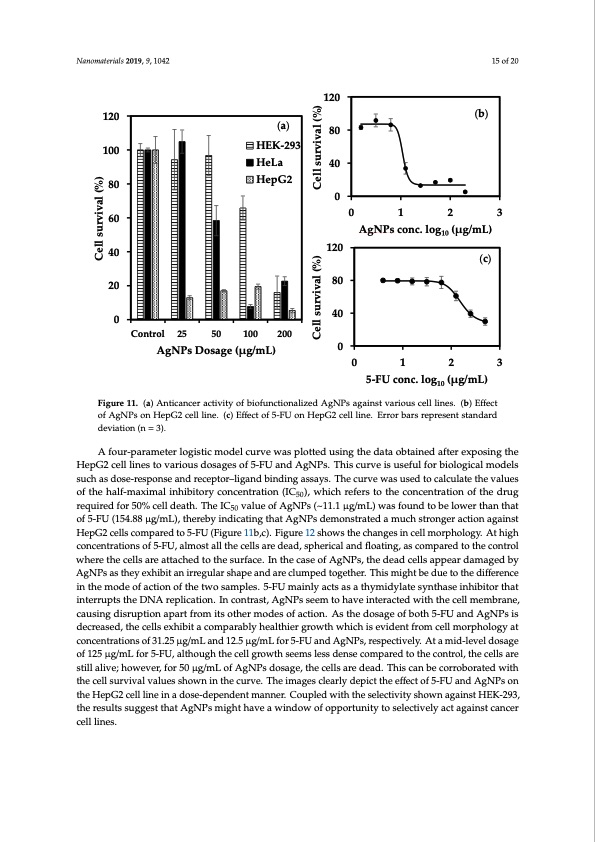
PDF Publication Title:
Text from PDF Page: 015
is evident from cell morphology at concentrations of 31.25 μg/mL and 12.5 μg/mL for 5-FU and AgNPs, respectively. At a mid-level dosage of 125 μg/mL for 5-FU, although the cell growth seems less dense compared to the control, the cells are still alive; however, for 50 μg/mL of AgNPs dosage, the cells are dead. This can be corroborated with the cell survival values shown in the curve. The images clearly depict the effect of 5-FU and AgNPs on the HepG2 cell line in a dose-dependent Nanomaterials 2019, 9, 1042 15 of 20 manner. Coupled with the selectivity shown against HEK-293, the results suggest that AgNPs might have a window of opportunity to selectively act against cancer cell lines. 120 80 40 0 (b) 0123 AgNPs conc. log10 (μg/mL) 120 100 80 60 40 20 0 Control AgNPs Dosage (μg/mL) 25 50 100 200 (a) HEK-293 HeLa HepG2 120 80 40 0 0123 5-FU conc. log10 (μg/mL) (c) Figure 11. (a) Anticancer activity of biofunctionalized AgNPs against various cell lines. (b) Effect Figure 11. (a) Anticancer activity of biofunctionalized AgNPs against various cell lines. (b) Effect of of AgNPs on HepG2 cell line. (c) Effect of 5-FU on HepG2 cell line. Error bars represent standard AgNPs on HepG2 cell line. (c) Effect of 5-FU on HepG2 cell line. Error bars represent standard deviation (n = 3). deviation (n = 3). A four-parameter logistic model curve was plotted using the data obtained after exposing the HepG2 cell lines to various dosages of 5-FU and AgNPs. This curve is useful for biological models such as dose-response and receptor–ligand binding assays. The curve was used to calculate the values of the half-maximal inhibitory concentration (IC50), which refers to the concentration of the drug required for 50% cell death. The IC50 value of AgNPs (~11.1 μg/mL) was found to be lower than that of 5-FU (154.88 μg/mL), thereby indicating that AgNPs demonstrated a much stronger action against HepG2 cells compared to 5-FU (Figure 11b,c). Figure 12 shows the changes in cell morphology. At high concentrations of 5-FU, almost all the cells are dead, spherical and floating, as compared to the control where the cells are attached to the surface. In the case of AgNPs, the dead cells appear damaged by AgNPs as they exhibit an irregular shape and are clumped together. This might be due to the difference in the mode of action of the two samples. 5-FU mainly acts as a thymidylate synthase inhibitor that interrupts the DNA replication. In contrast, AgNPs seem to have interacted with the cell membrane, causing disruption apart from its other modes of action. As the dosage of both 5-FU and AgNPs is decreased, the cells exhibit a comparably healthier growth which is evident from cell morphology at concentrations of 31.25 μg/mL and 12.5 μg/mL for 5-FU and AgNPs, respectively. At a mid-level dosage of 125 μg/mL for 5-FU, although the cell growth seems less dense compared to the control, the cells are still alive; however, for 50 μg/mL of AgNPs dosage, the cells are dead. This can be corroborated with the cell survival values shown in the curve. The images clearly depict the effect of 5-FU and AgNPs on the HepG2 cell line in a dose-dependent manner. Coupled with the selectivity shown against HEK-293, the results suggest that AgNPs might have a window of opportunity to selectively act against cancer cell lines. Cell survival (%) Cell survival (%) Cell survival (%)PDF Image | Biosynthesis of Silver Nanoparticles Talaromyces purpurogenus

PDF Search Title:
Biosynthesis of Silver Nanoparticles Talaromyces purpurogenusOriginal File Name Searched:
nanomaterials-09-01042.pdfDIY PDF Search: Google It | Yahoo | Bing
Turbine and System Plans CAD CAM: Special for this month, any plans are $10,000 for complete Cad/Cam blueprints. License is for one build. Try before you buy a production license. More Info
Waste Heat Power Technology: Organic Rankine Cycle uses waste heat to make electricity, shaft horsepower and cooling. More Info
All Turbine and System Products: Infinity Turbine ORD systems, turbine generator sets, build plans and more to use your waste heat from 30C to 100C. More Info
CO2 Phase Change Demonstrator: CO2 goes supercritical at 30 C. This is a experimental platform which you can use to demonstrate phase change with low heat. Includes integration area for small CO2 turbine, static generator, and more. This can also be used for a GTL Gas to Liquids experimental platform. More Info
Introducing the Infinity Turbine Products Infinity Turbine develops and builds systems for making power from waste heat. It also is working on innovative strategies for storing, making, and deploying energy. More Info
Need Strategy? Use our Consulting and analyst services Infinity Turbine LLC is pleased to announce its consulting and analyst services. We have worked in the renewable energy industry as a researcher, developing sales and markets, along with may inventions and innovations. More Info
Made in USA with Global Energy Millennial Web Engine These pages were made with the Global Energy Web PDF Engine using Filemaker (Claris) software.
Infinity Turbine Developing Spinning Disc Reactor SDR or Spinning Disc Reactors reduce processing time for liquid production of Silver Nanoparticles.
| CONTACT TEL: 608-238-6001 Email: greg@infinityturbine.com | RSS | AMP |